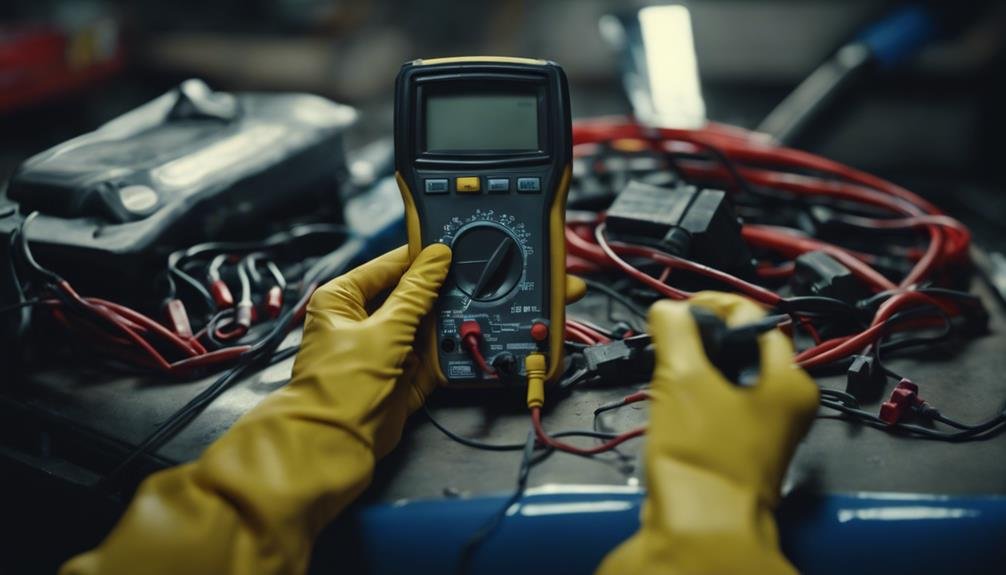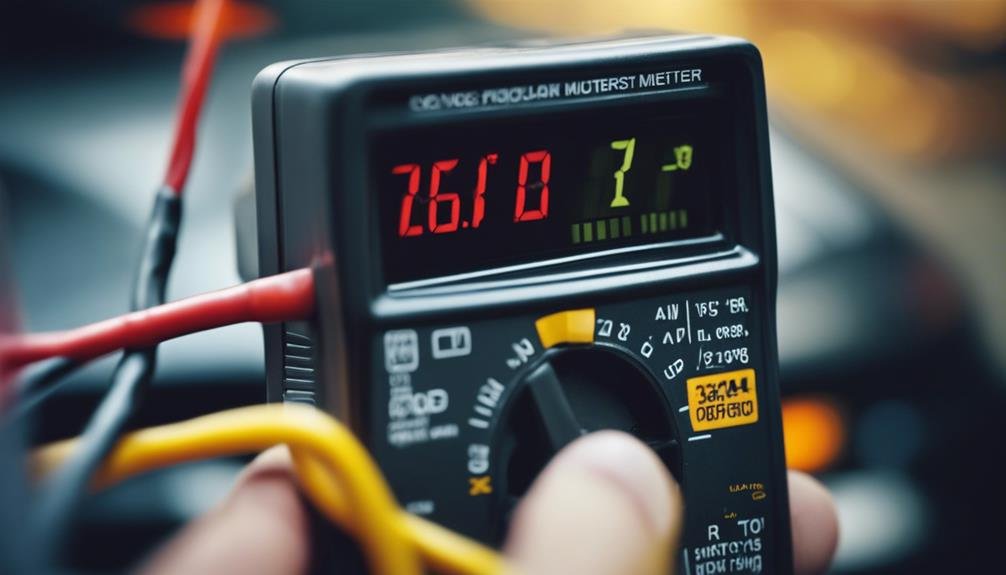To test if your alternator is charging, start by setting your multimeter to DC voltage mode and connecting the probes to the alternator terminals. With the engine off, you should read around 12.6 volts, and when running, it should be between 14.2-14.7 volts. Next, locate the alternator terminals, usually on the back or side of the housing, and identify the positive and negative connections. Then, check the voltage with the engine running, aiming for 13.5-14.5 volts. If your readings are off, it may indicate an issue. Continue testing at idle and verifying the charging voltage to make sure your alternator is functioning properly, and you'll soon uncover the state of your car's electrical system.
Key Takeaways
- Set your multimeter to DC voltage mode and above 15 volts range to ensure accurate readings.
- Attach the black probe to the negative terminal and the red probe to the positive terminal of the alternator.
- A healthy alternator should produce 13.5-14.5 volts when the engine is running, and around 12.6 volts when the engine is off.
- Check the voltage at the battery terminals to verify the alternator's charging voltage, which should be between 13.5-14.5 volts.
- A voltage reading below 13.5 volts may indicate undercharging, while a reading above 14.5 volts may indicate overcharging.
Preparing Your Multimeter
To guarantee accurate readings, set your multimeter to DC voltage mode and select a range above 15 volts to measure the alternator's output. This is vital for a successful alternator test.
When measuring the alternator's voltage, it's important to confirm your multimeter is set correctly to avoid incorrect readings. By selecting the correct range, you'll be able to accurately measure the voltage output of your alternator.
Before starting the test, make sure to clean the alternator terminals for better contact. This simple step can prevent faulty readings and ensure a reliable test.
When connecting your multimeter, remember to attach the black probe to the negative terminal and the red probe to the positive terminal.
During the test, look for signs of a healthy alternator, such as a voltage reading around 12.6 volts when the car is off and 14.2-14.7 volts when the engine is running.
Locating the Alternator Terminals
You'll need to locate the alternator terminals, usually found on the back or side of the alternator housing, to access the electrical connections for charging and power distribution.
When diagnosing charging issues in your car, understanding the layout and function of the alternator terminals is important for repair. Typically, the alternator has two terminals: one for the positive connection and one for the negative terminal. To test the alternator's charging capability, you'll need to access these terminals.
Here are the key things to keep in mind when locating the alternator terminals:
- Terminal location: Alternator terminals are usually found on the back or side of the alternator housing.
- Positive and negative connections: Identify the positive and negative terminals to make sure correct connections for charging and power distribution.
- Electrical connections: The terminals provide access to the electrical connections necessary for charging and power distribution in your car.
- Diagnosing charging issues: Locating and understanding the alternator terminals is important for diagnosing and repairing charging issues in your vehicle.
Checking the Alternator Voltage

When the engine is running, your alternator should produce a voltage output between 13.5 and 14.5 volts, which you can check using a voltmeter at the battery terminals. This voltage range indicates that your alternator is functioning properly and providing sufficient power to your vehicle's electrical system.
To check the alternator voltage, connect the voltmeter leads to the positive and negative battery terminals, ensuring the engine is running. Take note of the voltage reading, as it will indicate the alternator's charging capability. Low voltage readings below 13.5 volts may indicate an issue with the alternator's charging capability, while high voltage readings above 14.5 volts could signify an overcharging problem with the alternator.
Monitoring the alternator voltage is essential for ensuring the proper functioning of the vehicle's electrical system. By checking the voltage output, you'll be able to identify any potential issues and address them promptly, preventing damage to your vehicle's electrical components.
Testing the Alternator at Idle
Measuring the alternator's output voltage at idle with a voltmeter gives you a snapshot of its charging capability under normal driving conditions. This test helps you identify if the alternator is producing a healthy voltage reading, which is crucial for proper battery charging and overall vehicle performance.
Here are some key points to keep in mind when testing the alternator at idle:
- A healthy alternator should produce around 13.8 to 14.2 volts at idle.
- Lower voltage readings at idle may indicate an issue with the alternator.
- If the alternator fails to maintain proper voltage at idle, further inspection or repairs may be necessary.
- Testing the alternator at idle helps assess its charging capability under normal driving conditions.
Verifying the Charging Voltage

Now that you've assessed the alternator's output voltage at idle, it's time to verify the charging voltage when the engine is running. To do this, use a voltmeter to measure the charging voltage directly at the battery terminals for accurate readings. A healthy alternator should produce a charging voltage between 13.5 and 14.5 volts when the engine is running.
| Alternator Status | Voltage Reading | Diagnosis |
|---|---|---|
| Healthy | 13.5-14.5 volts | Normal charging voltage |
| Undercharging | <13.5 volts | Alternator may not be producing enough power |
| Overcharging | >14.5 volts | Alternator may be producing too much power |
Lower voltage readings may indicate an undercharging alternator, while higher readings suggest overcharging. Consistent voltage fluctuations or readings outside the normal range can signal potential alternator issues. Verifying the charging voltage is an important step in determining the health and functionality of your alternator, and ultimately, your car's electrical system. By conducting this test, you'll be able to identify any potential issues and take corrective action to make sure your alternator is functioning properly.
Interpreting the Test Results
You've got the test results, but what do they mean? Now that you've measured your alternator's voltage output, it's time to interpret the results.
Here's what to look for:
- Ideal range: If your reading falls between 13.8 and 15.3 volts, your alternator is likely functioning properly, providing a stable voltage output.
- Undercharging: If your reading is below 13.8 volts, it may indicate an undercharging alternator, which can be a sign of a failing alternator.
- Overcharging: Conversely, readings above 15.3 volts could suggest an overcharging alternator, which can also be a sign of alternator trouble.
- Unstable readings: If your readings are fluctuating or unstable, it may indicate a problem with your alternator that requires further inspection.
Frequently Asked Questions
How Do I Tell if My Alternator Is Charging?
You're wondering if your alternator is charging, right? To find out, you'll need to measure the battery voltage with a voltmeter while the engine's running – it should read between 13.5 and 14.5 volts for a healthy alternator.
What Is the Easiest Way to Test an Alternator?
You're looking for the easiest way to test an alternator? Simply grab a voltmeter, measure the battery voltage with the engine off and on, and check if it's within the 13.5-14.5 volt range when running.
How to Check if an Alternator Is Charging With a Multimeter?
You're wondering how to check if an alternator is charging with a multimeter? Simply set your multimeter to DCV, connect the cables to the battery terminals, and read the voltage; 14.2-14.7 volts indicates proper charging.
Do You Check Alternator With Car Running?
You're wondering if you should check the alternator with the car running – yes, you can and should, as it helps assess its performance under load, ensuring it's functioning properly.
Can You Disconnect Battery While Car Is Running to Check Alternator?
You shouldn't disconnect the battery while the car is running to check the alternator, as it can cause voltage spikes, damaging sensitive electronics and putting you at risk; it's a hazardous and unnecessary test method.
Conclusion
Now that you've completed the tests, you've likely confirmed whether your alternator is charging properly.
If your multimeter readings indicate a voltage within the 13.5-14.5V range, your alternator is functioning correctly.
However, if the voltage is notably lower, it may be a sign of a faulty alternator or other electrical system issues.
Consult a professional if you're unsure about the results or need further assistance.
